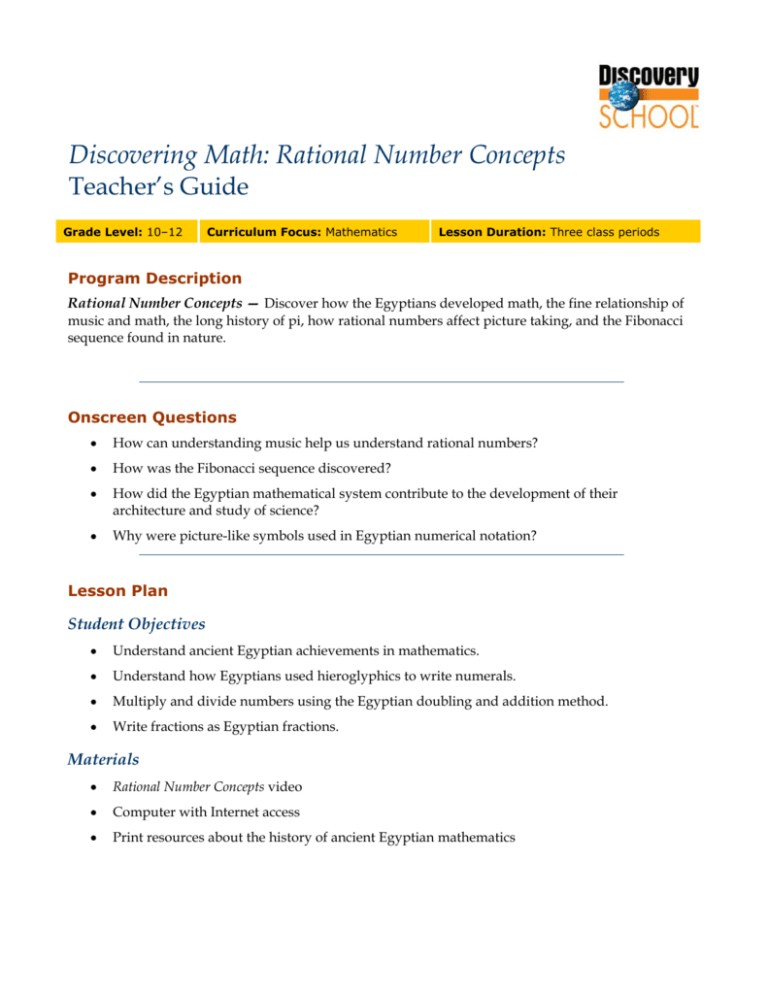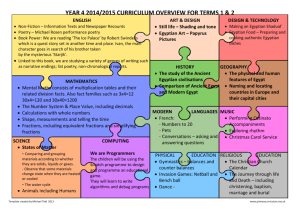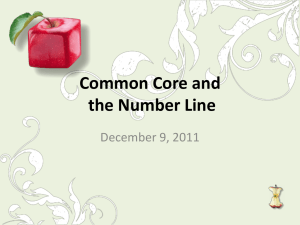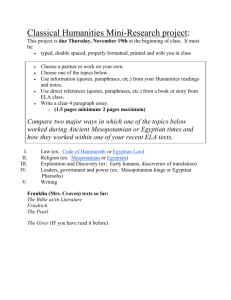
Discovering Math: Rational Number Concepts
Teacher’s Guide
Grade Level: 10–12
Curriculum Focus: Mathematics
Lesson Duration: Three class periods
Program Description
Rational Number Concepts — Discover how the Egyptians developed math, the fine relationship of
music and math, the long history of pi, how rational numbers affect picture taking, and the Fibonacci
sequence found in nature.
Onscreen Questions
•
How can understanding music help us understand rational numbers?
•
How was the Fibonacci sequence discovered?
•
How did the Egyptian mathematical system contribute to the development of their
architecture and study of science?
•
Why were picture-like symbols used in Egyptian numerical notation?
Lesson Plan
Student Objectives
•
Understand ancient Egyptian achievements in mathematics.
•
Understand how Egyptians used hieroglyphics to write numerals.
•
Multiply and divide numbers using the Egyptian doubling and addition method.
•
Write fractions as Egyptian fractions.
Materials
•
Rational Number Concepts video
•
Computer with Internet access
•
Print resources about the history of ancient Egyptian mathematics
Discovering Math: Rational Number Concepts
Teacher’s Guide
2
Procedures
1. Have students research Egyptian hieroglyphics using print and Web resources. The following
Web sites are a good starting point:
•
Egyptian Hieroglyphics
http://www.greatscott.com/hiero/index.html
•
Egyptian hieroglyphic
http://en.wikipedia.org/wiki/Hieroglyph
•
Hieroglyphics!
http://www.isidore-of-seville.com/hieroglyphs/
•
Online Hieroglyphics Translator
http://www.quizland.com/hiero.htm
Have each student use an online hieroglyphics translator to create a poster written in
hieroglyphics with an English translation on the other side. Divide students into groups of four.
Have the students in each group translate each other’s posters.
2. Have students research the pyramids of Egypt using print and Web resources. The following
web sites are a good starting point:
•
NOVA Online/Pyramids -- The Inside Story
http://www.pbs.org/wgbh/nova/pyramid/
•
Egyptian pyramids
http://en.wikipedia.org/wiki/Egyptian_pyramids
•
Egypt Pyramids Index
http://www.touregypt.net/featurestories/pyramids.htm
3. When students have completed their research, ask them to summarize their findings in a onepage report.
4. Have each student choose a partner. Ask students to share their reports with their partners and
answer any questions. Then have students summarize their partner’s report for the class,
including at least three interesting facts.
5. Have the students write Egyptian hieroglyphic symbols for 1, 10, 100, 1000, 10000, 100000, and
1000000. Ask students how the Egyptians would write a number such as 356. (Use three-100
symbols, five-10 symbols, and six-1 symbols). Ask students why a symbol for zero was not
necessary. (Each symbols represents a powers of 10. A number like 104 would be written with one-100
symbol, no 10 symbol, and four-1 symbols.)
6. Show students examples of multiplying two whole numbers using the doubling and addition
method. Allow students time to practice.
Published by Discovery Education. © 2005. All rights reserved.
Discovering Math: Rational Number Concepts
Teacher’s Guide
3
7. Show examples of dividing two whole numbers with no remainder using the doubling and
addition method. Allow students time to practice.
8. Show examples of rewriting fractions as unit fractions. Allow practice time.
9. Show examples of multiplying a whole number and a mixed number using the doubling and
addition method. Allow time to practice.
Assessment
Use the following three-point rubric to evaluate students’ work during this lesson.
•
3 points: Students were highly engaged in class discussions; produced complete reports
including all the requested information; clearly demonstrated the ability to multiply two
whole numbers, multiply a whole number and a mixed number, and divide two whole
numbers with no remainder using the doubling and addition method; and clearly
demonstrated the ability to write fractions as unit fractions.
•
2 points: Students participated in class discussions; produced an adequate report including
most of the requested information; satisfactorily demonstrated the ability to multiply two
whole numbers, multiply a whole number and a mixed number, and divide two whole
numbers with no remainder using the doubling and addition method; and clearly
demonstrated the ability to write fractions as unit fractions.
•
1 point: Students participated minimally in class discussions; created an incomplete report
with little or none of the requested information; were not able to multiply two whole
numbers, multiply a whole number and a mixed number, or divide two whole numbers
with no remainder using the doubling and addition method; or did not clearly demonstrate
the ability to write fractions as unit fractions.
Vocabulary
Egyptian fraction
Definition: A fraction expressed as a sum of unit fractions, where all of the unit fractions in the
sum are different
1
= 13 + 17 + 483
.
Context: Expressed as an Egyptian fraction, 11
23
hieroglyphics
Definition: The picture script of the ancient Egyptians
Context: The study of ancient Egyptian history was made easier by translating the hieroglyphic
symbols found on the walls of temples and tombs.
greedy method
Definition: An algorithm that generates an Egyptian fraction from a given fraction by finding
largest denominators first
Published by Discovery Education. © 2005. All rights reserved.
Discovering Math: Rational Number Concepts
Teacher’s Guide
Context: The first step in the greedy method for converting
4
11
23
to an Egyptian fraction is to
divide 23 by 11. Then round the answer up to the next whole number and find the reciprocal of
.
the rounded number. 23 ÷11 = 2 111 . 2 111 rounds up to 3. 13 is the largest unit fraction in 11
23
multiplicand
Definition: A number that is to be multiplied by another number
Context: In the multiplication 6 × 7, 7 is the multiplicand.
multiplier
Definition: A number by which another number is to be multiplied
Context: In the multiplication 6 × 7, 6 is the multiplier.
Academic Standards
National Council of Teachers of Mathematics (NCTM)
The National Council of Teachers of Mathematics provides guidelines for teaching mathematics in
grades K–12 to promote mathematical literacy. To view the standards, visit this Web site:
http://standards.nctm.org/document/chapter3/index.htm.
This lesson plan addresses the following thematic standards:
•
Understand numbers, ways of representing numbers, relationships among numbers, and
number systems; Understand meanings of operations and how they relate to one another;
Compute fluently and make reasonable estimates
Mid-continent Research for Education and Learning (McREL)
McREL’s Content Knowledge: A Compendium of Standards and Benchmarks for K–12 Education
addresses 14 content areas. To view the standards and benchmarks, visit
http://www.mcrel.org/compendium/browse.asp.
This lesson plan addresses the following national standards:
•
Mathematics: Understands and applies basic and advanced properties of the concepts of
numbers; Uses basic and advanced procedures while performing the processes of
computation
•
Science: Physical Science: Understands the structure and properties of matter; Understands
the sources and properties of energy
•
World History: Understands the major characteristics of civilization and the development of
civilizations in Mesopotamia, Egypt, and the Indus Valley
Published by Discovery Education. © 2005. All rights reserved.
Discovering Math: Rational Number Concepts
Teacher’s Guide
5
Support Materials
Develop custom worksheets, educational puzzles, online quizzes, and more with the free teaching tools
offered on the Discoveryschool.com Web site. Create and print support materials, or save them to a
Custom Classroom account for future use. To learn more, visit
•
http://school.discovery.com/teachingtools/teachingtools.html
DVD Content
This program is available in an interactive DVD format. The following information and activities are
specific to the DVD version.
How To Use the DVD
The DVD starting screen has the following options:
Play Video—This plays the video from start to finish. There are no programmed stops, except by
using a remote control. With a computer, depending on the particular software player, a pause
button is included with the other video controls.
Video Index—Here the video is divided into five parts (see below), indicated by video thumbnail
icons. Watching all parts in sequence is similar to watching the video from start to finish. Brief
descriptions and total running times are noted for each part. To play a particular segment, press
Enter on the remote for TV playback; on a computer, click once to highlight a thumbnail and read
the accompanying text description and click again to start the video.
Curriculum Units—These are specially edited video segments pulled from different sections of the
video (see below). These nonlinear segments align with key ideas in the unit of instruction. They
include onscreen pre- and post-viewing questions, reproduced below in this Teacher’s Guide. Total
running times for these segments are noted. To play a particular segment, press Enter on the TV
remote or click once on the Curriculum Unit title on a computer.
Standards Link—Selecting this option displays a single screen that lists the national academic
standards the video addresses.
Teacher Resources—This screen gives the technical support number and Web site address.
Video Index
I. Rational Numbers and Music (5 min.)
See how Pythagoras made the first connection between rational numbers and music. Learn how the
concept of rational numbers influenced music and how music influenced mathematics.
Published by Discovery Education. © 2005. All rights reserved.
Discovering Math: Rational Number Concepts
Teacher’s Guide
6
II. Fibonacci Sequence (6 min.)
See how much of nature’s beauty follows patterns that can be expressed as mathematical
sequences. Learn about the irrational number phi and how it relates to nature, art, and architecture.
III. Pi: Squaring the Circle (4 min.)
The ratio of a circle’s circumference to its diameter is the irrational number pi. Learn that
mathematicians working to prove that pi is a rational number tried to “square the circle.”
IV. Rational Expressions and Equations (5 min.)
Learn how rational numbers are used to determine the power of a lens, or its focal length. Learn
how the lens formula can help you take sharper photographs.
V. Math and Culture: The Ancient Egyptians (25 min.)
Explore the ancient Egyptians’ number system, their process of doubling and addition to multiply
and divide, expressing fractions in terms of unit fractions, and how a modern-day computer
algorithm relates to Egyptian fractions.
Curriculum Units
1. Rational Numbers and Music
Pre-viewing question
Q: How are mathematics and music related?
A: Answers will vary.
Post-viewing question
Q: What is the equation for finding the frequency F(n) of a note n half-steps away from a given
note? What is the frequency of the note five half-steps up from A(440 Hz)?
A: The equation for finding the frequency F(n) of a note n half-steps away from a given note is
1
F (n) = A 212
n
, where A is the frequency of the given note, and n is the number of half-steps away
from the given note A.
5
1
F (5) = 440 212 ≈ 587.3
The frequency of the note five half-steps up from A(440 Hz) is about 587.3 Hz.
2. Fibonacci Sequence
Pre-viewing question
Q: What is an arithmetic sequence? What is a geometric progression?
A: An arithmetic sequence, or progression, is a sequence of real numbers that has a common
difference between the terms. A geometric progression is a sequence of real numbers that has a
common ratio between the terms.
Published by Discovery Education. © 2005. All rights reserved.
Discovering Math: Rational Number Concepts
Teacher’s Guide
7
Post-viewing question
Q: What is a formula for the Fibonacci sequence? What is the value of the 10th term in the Fibonacci
sequence?
A: F1 = 1
Fn = Fn – 1 + Fn – 2
F10 = 55
3. The Irrational Number Phi
Pre-viewing question
Q: What is an example of an irrational number?
A: Answers will vary.
Post-viewing question
Q: What everyday objects are proportional to the irrational number phi?
A: Answers will vary.
4. Pi: Squaring the Circle
Pre-viewing question
Q: What is an irrational number?
A: An irrational number is a number that is not rational, one that cannot be expressed as a
terminating or repeating decimal.
Post-viewing question
Q: What is a transcendental number? Give an example. Then give an example of an irrational
number that is not transcendental.
A: A transcendental number is a number that cannot be written as the root of a polynomial
equation. Pi is a transcendental number. Phi and the square root of 2 are examples of irrational
numbers that are not transcendental.
5. Rational Expressions and Equations
Pre-viewing question
Q: How might you use mathematics in photography?
A: Answers will vary.
Post-viewing question
Q: What is the lens formula?
A: The lens formula is
1 1 1
+ =
o i f
, where o is the object distance, i is the image distance, and f is the
focal length.
6. Ancient Egyptian Civilization
Q: How has Egyptian civilization influenced your life?
A: Answers will vary.
Published by Discovery Education. © 2005. All rights reserved.
Discovering Math: Rational Number Concepts
Teacher’s Guide
8
Post-viewing question
Q: What do you think was the greatest accomplishment in Egyptian mathematics?
A: Answers will vary.
7. Egyptian Number System
Pre-viewing question
Q: Why does a society need a number system?
A: Answers will vary.
Post-viewing question
Q: What are some features of the ancient Egyptian number system?
A: Answers will vary.
8. Egyptian Multiplication
Pre-viewing question
Q: How do you multiply 6
5
8
by 9?
A: Answers will vary.
Post-viewing question
Q: How did the Egyptians multiply?
A: Answers will vary.
9. Egyptian Division
Pre-viewing question
Q: Why do we have to memorize times tables to multiply and divide in our number system?
A: Answers will vary.
Post-viewing question
Q: How did the ancient Egyptians divide?
A: Answers will vary.
10. Egyptian Fractions
Pre-viewing question
Q: How do you add
1 1
+
2 5
?
A: Answers will vary.
Post-viewing question
Q: How do you convert
4
5
to a sum of unit fractions?
A: Answers will vary. Possible conversion:
4 1 1 1
= + +
5 2 4 20
Published by Discovery Education. © 2005. All rights reserved.










